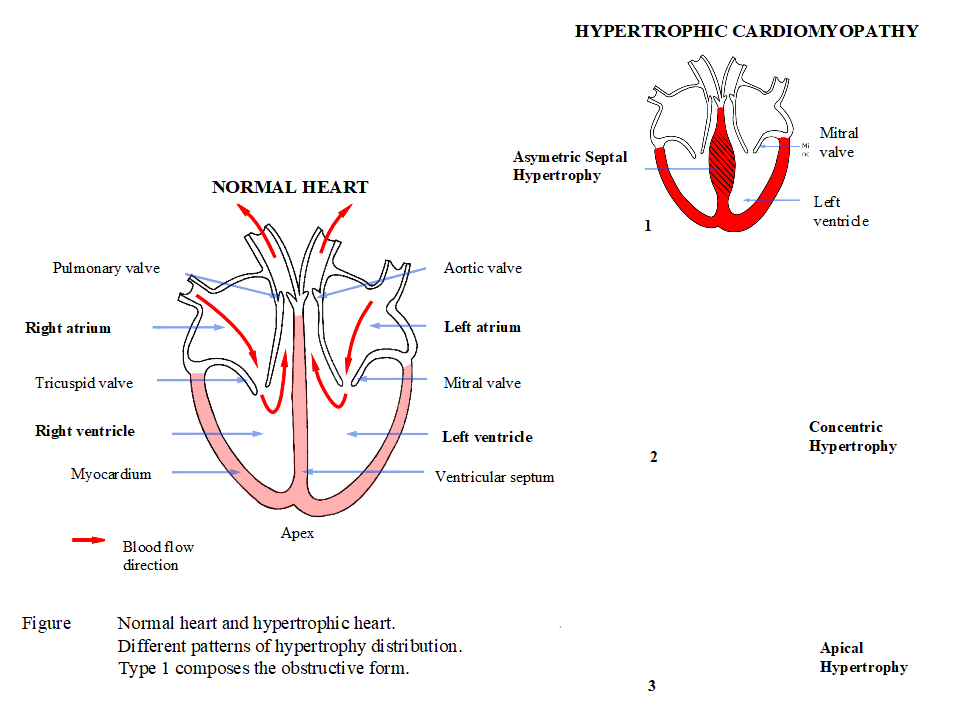MurciaSalud
CSUR ERN
Introduction
Hypertrophic cardiomyopathy is a disease of the heart muscle characterised by thickening of the heart wall. Cardiomyopathy means myocardium (cardiac muscle) disease and hypertrophic means an increase in size (thickness). The symptoms of the disease may vary widely among patients.
Obstructive type
For 1 in 4 patients with this condition, the excess muscle blocks blood flow out of the ventricle, this is called ¿obstructive hypertrophic cardiomyopathy¿. The heart has to make an extra effort to make up for this inconvenience. Therefore, patients with this condition tend to have more limitations and they need more intense treatment (figure 1, type 1).
Drug therapy (beta blockers and calcium antagonists, which decrease the strength of the heart rhythm and slow it down) improves symptoms and the heart effort capacity by relaxing the heart and reducing obstruction. This therapy is effective in most patients (about 90%).

There are cases in which the medication either does not agree with the patient or its effects are not as we would have liked. In these cases, there are other solutions.
- Pacemaker. Some patients improve when they receive a pacemaker. The pacemaker¿s function is to speed up contraction in some areas and slow it down in other areas. The part of the heart muscle where obstruction occurs contracts later, and in this way, it does not block blood outflow. This treatment works for approximately 1 in 3 patients. The pacemaker is placed in the left shoulder area with local anaesthesia and a two-day hospitalization period is necessary.
Risks: The complications of a pacemaker are rare. Most complications are mild ¿ hematomas, wire displacement, which requires a second intervention. Severe complications are very rare (approximately 1 in 1000).
- Alcohol septal ablation. This technique is performed through a catheter and with local anaesthesia in the wrist or groin area. It has been performed for over 20 years. An approximate one-week hospitalization period is necessary. A small infarction is provoked when alcohol is injected in the area where there is excess muscle. At the beginning, the area where the procedure has been performed stops contracting but the thickness is the same. It is necessary to implant a temporary pacemaker for a few days, for safety reasons. This pacemaker is removed before discharge. It is necessary to be in hospital for a week after this procedure. During the first few weeks, thickness decreases gradually up to approximately 5 mm. While muscle thickness decreases so does obstruction and symptoms improve. A 6-month period or even a year may still be necessary to obtain the final result. 80% of patients who are treated with this technique improve remarkably while for 20% of patients the result is not good.
Risks: You should know that there are certain risks that need considering before making a decision. About half of all patients have their heart electrical system affected by alcohol and they need a pacemaker for a few days. A few patients (<10%) do not recover the normal electrical rhythm and they need a permanent pacemaker. Severe complications are rare (approximately 1%) in expert hands, but the risk exists.
- Myectomy. Myectomy is the oldest procedure. 50 years ago, the earliest cases of hypertrophic cardiomyopathy were treated with this procedure. A surgery with general anaesthesia is necessary. The surgeon removes a portion of the heart muscle from the thickened area with a scalpel. A one-week hospitalization period is necessary. The postoperative period lasts a few weeks and the patient improves quickly. About 90% of people operated on in hospitals with experience in this technique clearly improve in their condition and obstruction disappears almost entirely.
Risks of a myectomy: You should know that there are certain risks that need considering before making a decision. A few patients have their heart electrical system injured and they need a permanent pacemaker (5%). Severe complications are rare (approximately 3%) in expert hands, but the risk exists.
